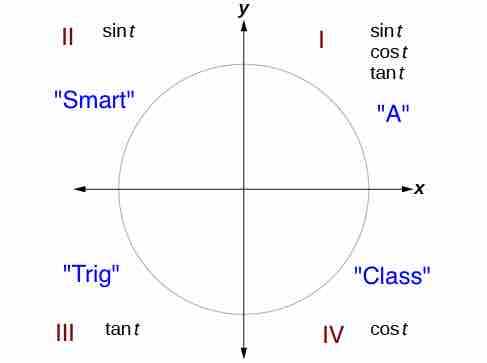Trigonometric Functions of Special Angles
Recall that certain angles and their coordinates, which correspond to

Unit circle
Special angles and their coordinates are identified on the unit circle.
The angles identified on the unit circle above have relatively simple expressions. Such simple expressions generally do not exist for other angles. Some examples of the algebraic expressions for the sines of special angles are:
The expressions for the cosine functions of these special angles are also simple.
Note that while only sine and cosine are defined directly by the unit circle, tangent can be defined as a quotient involving these two:
Tangent functions also have simple expressions for each of the special angles.
We can observe this trend through an example. Let's find the tangent of
First, we can identify from the unit circle that:
We can easily calculate the tangent:
Memorizing Trigonometric Functions
An understanding of the unit circle and the ability to quickly solve trigonometric functions for certain angles is very useful in the field of mathematics. Applying rules and shortcuts associated with the unit circle allows you to solve trigonometric functions quickly. The following are some rules to help you quickly solve such problems.
Signs of Trigonometric Functions
The sign of a trigonometric function depends on the quadrant that the angle falls in. To help remember which of the trigonometric functions are positive in each quadrant, we can use the mnemonic phrase “A Smart Trig Class.” Each of the four words in the phrase corresponds to one of the four quadrants, starting with quadrant I and rotating counterclockwise. In quadrant I, which is “A,” all of the trigonometric functions are positive. In quadrant II, “Smart,” only sine is positive. In quadrant III, “Trig,” only tangent is positive. Finally, in quadrant IV, “Class,” only cosine is positive. is positive.

Sign rules for trigonometric functions
The trigonometric functions are each listed in the quadrants in which they are positive.
Identifying Values using Reference Angles
Take a close look at the unit circle, and note that
Reference angles in quadrant I are used to identify which value any angle in quadrants II, III, or IV will take. This means that we only need to memorize the sine and cosine of three angles in quadrant I:
For any given angle in the first quadrant, there is an angle
in the second quadrant with the same sine value. Because the sine value
is the
Likewise, there will be an angle in the fourth
quadrant with the same cosine as the original angle. The angle with the
same cosine will share the same
As shown in the diagrams below, angle
Reference angles
In the left figure,
Recall that an angle’s reference angle is the acute angle,
Reference angles in each quadrant
For any angle in quadrants II, III, or IV, there is a reference angle in quadrant I.
Thus, in order to recall any sine or cosine of a special angle, you need to be able to identify its angle with the
These are the steps for finding a reference angle for any angle between
- An angle in the first quadrant is its own reference angle.
- For an angle in the second or third quadrant, the reference angle is
$|\pi - t|$ or$|180^{\circ} - t|$ . - For an angle in the fourth quadrant, the reference angle is
$2\pi - t$ or$360^{\circ} - t$ . If an angle is less than$0$ or greater than$2\pi$ , add or subtract$2\pi$ as many times as needed to find an equivalent angle between$0$ and$2\pi$ .
Since tangent functions are derived from sine and cosine, the tangent can be calculated for any of the special angles by first finding the values for sine or cosine.
Example
Find
First, note that
Angle $225^{\circ}$ on a unit circle
The angle
Subtract
In other words,
Recall that
However, the rules described above tell us that the sine of an angle in the third quadrant is negative. So we have
Following the same process for cosine, we can identify that
We can find